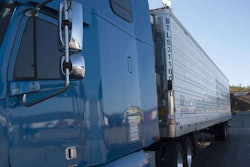Tire air pressure can have a profound effect on a tire’s life, fuel consumption, impact damage, and maintenance costs. As tire pressure increases and decreases, the tire’s footprint changes. This not only affects the load the tire can support and the tire’s traction, it also causes heat buildup and irregular wear.
Under-inflation is much worse than over-inflation because it causes additional belt flex and generates heat — the root cause of most tire failures.
Operating tires at 20% below the load recommended pressure can wear out the tire 25% faster and increase fuel consumption by 1.5%. Quick math reveals the cost of inefficient tire management programs.
When a tire is operating at 20% below the manufacturer’s recommended pressure that refers to 20% below the tire manufacturer’s tire pressure recommendation for the given loads. It is not the fleet manager’s target pressure. To make it easier to manage tire pressures, most fleets use a standard tire pressure that works for the average application in their fleet.
Here’s an example: a fleet manager selects a tire fleet pressure of 95 psi for the steer tire on its average truck. However, during the course of normal operation, a few trucks operate at their maximum load capacity. Assume the manufacturer’s load chart recommends an optimal tire pressure of 110 psi for that axle at that load rating. Going with the fleet standard 95 psi means the tire is now inflated 14% below the manufacturer’s recommended pressure. That equates to a lot of extra heat being generated. It is important not to confuse the fleet target tire pressure with the manufacturer’s recommended pressure chart for the load requirements.
While under-inflation is often to blame for tire problems, over-inflating tires is not a good idea either. Over-inflated tires are more vulnerable to tread cuts, sidewall damage, and impact damage. The right balance of pressure takes some tire management but can produce significant savings.
It’s important to remember that as tire temperatures increase, so does the tire pressure. It can increase 2 psi for each 10-degree temperature increase. Do not adjust a vehicle’s tire pressure when tires come in off the road. Let the tires rest and cool down before making adjustments. New tires can expand slightly in the first 2,000 miles and their air pressure should be rechecked regularly.
Unfortunately, rear dual tire conditions are often overlooked. Mismatched tread designs, out of spec dual mating circumferences, and slight air pressure variances can have a profound effect on a tire’s footprint, the co-efficiency rating, and also effects heat buildup.
Whether it’s the dual mating out of spec or a variance in air pressure between duals, one tire will be carrying more weight than the one next to it. One tire may roll more easily while the other just drags along. It’s as if the two tires are fighting each other and as a result, the tire temperature increases. Typically, the larger of the duals will have more tire inflection causing the sidewall belt package to flex more than designed. This can lead to zipper failures.
When selecting steer tire air pressure, keep in mind that steer tires often operate very close to the rated maximum tire load capacity and are often under-inflated for the weight carried. The air pressure margin can be very small yet critical in supporting the weight load.
How do you determine which pressure is right? When setting tire pressure standards, consider the axle rating, load, tire rating, and speed. Then consult the manufacturer’s tire pressure load chart. Pressure requirements can vary quite a bit by load application. Setting pressures by unit and application is time consuming, but it can also have great financial rewards.
Air pressure gauges can be a great savings or a useless expense. New gauges can be off by as much as 5 psi or more and a number of gauges lose calibration in just a couple weeks. Many of us have witnessed a technician letting the air out of a set of tires during a yard check because he thinks they are over-inflated only to see another technician pulling the truck into the shop that evening to air up the same tires.
To prevent this from occurring, invest in a very good quality shop master air pressure gauge and regulator plumbed into the shop air system. Assign a person to round up all the shop air gauges every week and adjust them as needed. Check each gauge at 100 psi and again at 50 psi. The Technology & Maintenance Council has a great bulletin for setting up the master shop gauge.
No discussion of tire inflation pressure is complete without looking at safety. Here are a couple safety tips:
- Never re-inflate a tire which was operated in a run flat condition or operated at 20% below the recommended tire pressure.
- Remove, dismount, and inspect the tire.
- If the tire is acceptable, air it up in a tire cage using a remote airing device and wear safety glasses. You may air up thousands of tires without a problem but it only takes one to seriously injure someone.
- A remote airing device should be used regardless of the amount of air needed.
- Advise your technicians that if they hear cracking while adding air to stop immediately.













